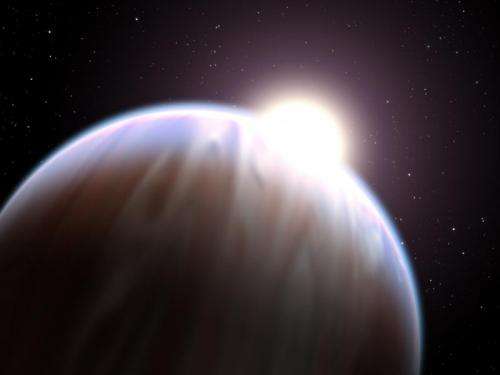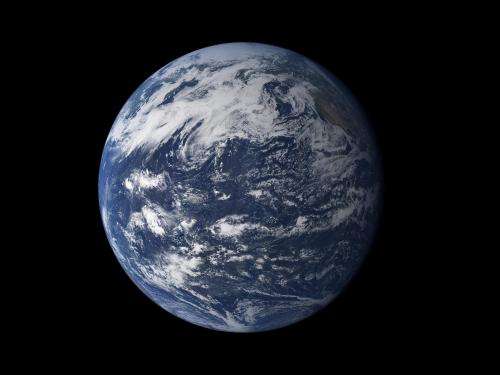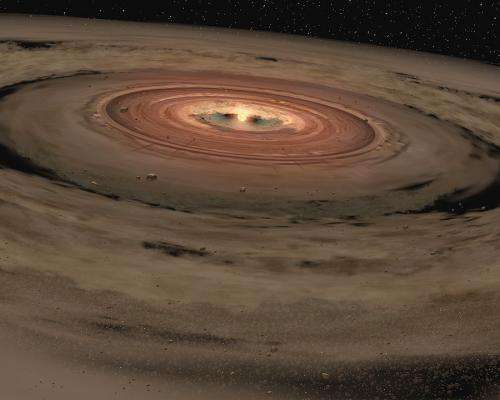Astronomers looking for clues to water's origins

A gas and dust cloud collapses to form a star. Amid a whirling disc of debris, little bits of rock coated with liquid water and ice begin to stick together. It is this stage of a star's formation that astronomers hope to learn more about how water cycles through a solar system, although this is also when some of the least evidence is available to study.
If water is created prior to stellar birth, then all planetary systems will be born with abundant water, giving rise to what could be life-friendly conditions throughout the universe. However, if this water is sometimes destroyed as the disc is formed, then water would not be as common in the cosmos.
Astronomers are eager to use the newly completed Atacama Large Millimeter Array (ALMA), an array of radio telescopes in the Atacama desert of northern Chile, and similar facilities to follow the story of water when planetary systems form. This is important because ALMA can watch solar systems being born, and help trace the evolution of water in young solar systems.
"The main parts that we are still missing are the story of when the cloud collapses, and then you go into the disc where the planets are formed. That is still the crucial time that we don't fully understand," said Ewine van Dishoeck, a Leiden University researcher.
Van Dishoeck recently led a paper on the formation and transport of water. The paper is available on the prepublishing site Arxiv, and has been accepted for publication as a chapter in Protostars and Planets VI (University of Arizona Press, 2014).
Van Dishoeck added: "We think we have good evidence based on modeling that our group has done, and the water that has been formed on the surfaces of dust grains prior to collapse mostly stays as ice on the grains when it enters the disc in which the planet forms. But that is something that we have not been able to fully trace observationally."
Water and life
The history of water on Earth can be linked to the history of life. Some researchers trace the arrival of water on Earth to striking meteors, which contained water as well as the ingredients for amino acids and DNA. If enough of these materials arrived in the right combinations, the theory goes, life would have followed.
Yet our understanding of water's origins on planets is limited because the science is so new.
This is all changing with the advent of new telescopes. NASA's Kepler space telescope found more than 2,700 planetary candidates during its primary mission, including many that are just a bit larger than Earth. These "super-Earths" could be even more habitable than our own planet because their bigger masses allow them to hang onto thicker atmospheres, and they potentially have more water than Earth itself.
Meanwhile, NASA's James Webb Space Telescope is well on its way for a 2018 launch. Once it goes into orbit, researchers hope to use it to detect the isotopes of water on other planets using infrared radiation.

"It will be able to see water deep in the terrestrial planet-forming regions around a star," said Edwin Bergin, a University of Michigan astronomer who coauthored the paper with van Dishoeck.
However, Bergin said that cold water vapor, found in the distant comet-forming zones of a disc, will be invisible to the telescope's instruments. For that, researchers will require archival data from the European Space Agency's Herschel telescope, which was shut down in 2013.
Wet or dry Earth?
Seeking water at different temperatures is important because it shows different stages of formation and evolution.
Based on models and observations, researchers believe that water forms from ice present in dense molecular clouds even before those clouds collapse to form stars. The water stays icy as the star begins to form, and doesn't appear to be too perturbed as accretion shocks ripple through the forming protoplanetary disc.
Observations from Herschel have revealed water reservoirs in the outer, icy belt of the disc as it begins to settle into clumps of matter. Additionally, NASA's Spitzer Space Telescope discovered water on the hot surface layers above and below the disc, close to the young star. A third zone of water is in the mid-plane of the disk, where terrestrial planets are born and a gaseous reservoir exists.
Models further suggest that the water acts as a substance for clumps of matter to stick together and form boulders. In Earth's solar system, it is unclear how the water got onto the planet, but there are three theories.
The prevailing theory, according to Bergin, is that icy comets or asteroids brought water into the inner part of the Solar System from beyond the snow line, or the spot in the solar system where the Sun is too far away to keep water in a gaseous state.
There are a couple of alternatives to the theory, however. One is that water vapor in the Earth's atmosphere originated from the founding of our Solar System, whose nebula was awash in water vapor.
Another theory is that water accreted on tiny dust grains at the beginning of the Solar System's history, sticking in tiny divots inside the grain lattices. The water continued to stay there even as those grains got bigger, became rocks and eventually formed planets and planetesimals.

Cometary mystery
Firming this all up, however, will require more observations. Researchers hope to find answers in the next decade from the discovery of "super-Earths," planets that are about two to 10 times the size of Earth.
Water only makes up 0.2 percent of the mass of Earth, which includes water in the oceans as well as in areas such as the Earth's plates. Super-Earths, however, could possess more water due to their greater gravity.
Figuring out habitability will need to go beyond astronomy, said van Dishoeck, to include disciplines as diverse as pure chemistry, mineralogy, geology, and physics. The multidisciplinary approach was something she experienced in small form as she wrote this paper with the other authors, she added.
"The science is bringing a lot of fields together, and I think that's sort of nice to show that no one field is really important," she said.
One potential area of collaboration is the question of hydrogen and deuterium (a hydrogen atom with a neutron in the nucleus) components in water. Researchers estimate that the ratio of deuterium to hydrogen (D/H) in water is higher on Earth than what the Sun and the inner solar system created.
Scientists have found several comets with D/H ratios that are similar to that of Earth's oceans, most famously in the comet 103P/Hartley 2 that was observed up close by NASA's Deep Impact spacecraft. (That said, the D/H discovery was made not by Deep Impact, but Herschel.) Yet that clue still doesn't tell us exactly where the water came from.
"We need to understand more about the D/H ratio in our solar system," Bergin said. "We need more statistics, more comets, more extrasolar planetary discs, to try to understand how this chemistry operates. This is where ALMA and JWST will also contribute in the future. It is like looking at the pieces of a billion year puzzle and through a multi-disciplinary effort in the coming decades we will be putting it together."
Journal information: arXiv
Provided by Astrobio.net




















